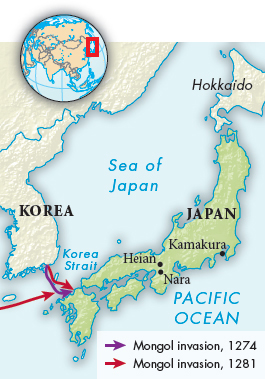Understanding World Societies:
Printed Page 381
Military Rule
The similarities between military rule in Japan and feudalism in medieval Europe during roughly the same period have fascinated scholars, as have the very significant differences. In Europe feudalism emerged out of the fusion of Germanic and Roman social institutions and flowered under the impact of Muslim and Viking invasions. In Japan military rule evolved from a combination of the native warrior tradition and Confucian ethical principles of duty to superiors.
The emergence of the samurai was made possible by the development of private landholding. The government land allotment system, copied from Tang China, began breaking down in the eighth century (much as it did in China). By the ninth century local lords had begun escaping imperial taxes and control by commending (formally giving) their land to tax-
Samurai resembled European knights in several ways. Both were armed with expensive weapons, and both fought on horseback. Just as the knight was supposed to live according to the chivalric code, so Japanese samurai were expected to live according to Bushido (or “way of the warrior”). Physical hardship was accepted as routine, and soft living was despised as weak and unworthy. Disloyalty brought social disgrace, which the samurai could avoid only through seppuku, ritual suicide by slashing his belly.

The Kamakura Shogunate derives its name from Kamakura, a city near modern Tokyo that was the seat of the Minamoto clan. The founder, Yoritomo, ruled the country much the way he ran his own estates, appointing his retainers to newly created offices. To cope with the emergence of hard-
Yoritomo’s wife, Masako, protected the interests of her own family, the Hōjōs, especially after Yoritomo died. She went so far as to force her first son to abdicate when he showed signs of preferring the family of his wife to the family of his mother. She later helped her brother take power away from her father. Thus the process of reducing power holders to figureheads went one step further in 1219 when the Hōjō family reduced the shogun to a figurehead. The Hōjō family held the reins of power for more than a century until 1333.
The Mongols’ two massive seaborne invasions in 1274 and 1281 (see “Chinggis’s Successors” in Chapter 12) were a huge shock to the shogunate. Although the Hōjō regents, with the help of a “divine wind” (kamikaze), repelled the Mongols, they were unable to reward their vassals in the traditional way because little booty was found among the wreckage of the Mongol fleets. Discontent grew among the samurai, and by the fourteenth century the entire political system was breaking down. Both the imperial and the shogunate families were fighting among themselves. As land grants were divided, samurai became impoverished.
The factional disputes among Japan’s leading families remained explosive until 1331, when the emperor Go-